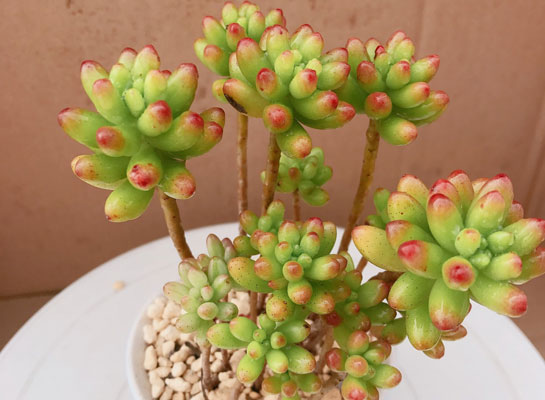Jelly Bean Plant: How to Grow & Care Sedum Rubrotinctum Succulent
Written by Iris
Jan 04 2023
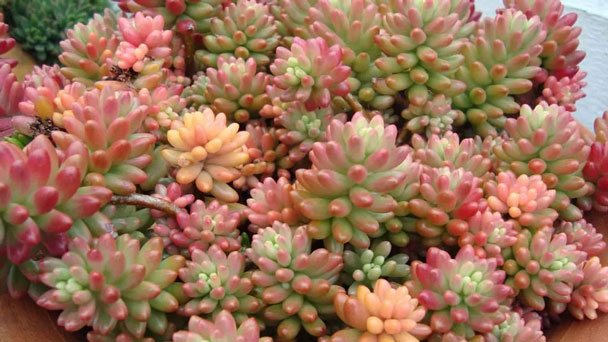
Jelly Bean Plant (Sedum rubrotinctum) is sedum succulent. Jelly Bean Plant grows rapidly and is easy to care for. Its leaves are redder in the sun, which is of great ornamental value. Here are details on how to grow and care for Jelly Bean Plant.
To do this, simply follow the step-by-step guide below: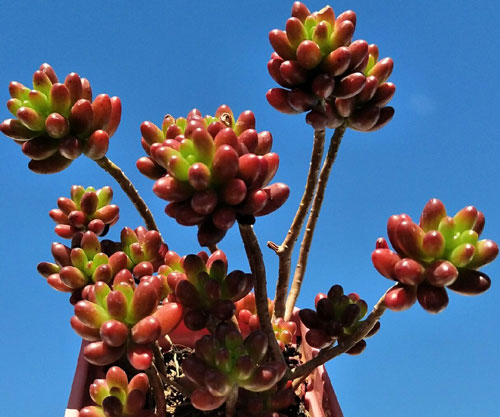
Here's a step-by-step guide on how to propagate your Jelly Bean plants from leaves.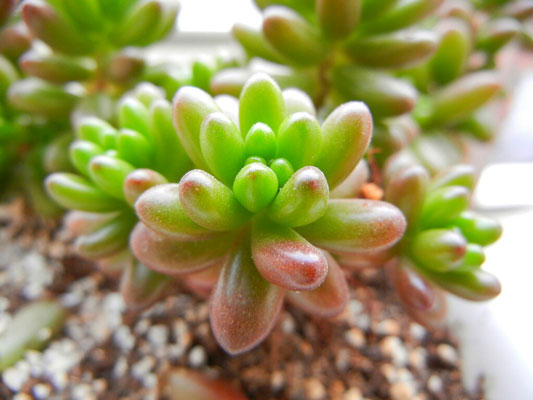
During a heatwave, make sure to move your Jelly Bean succulent to a shadier spot to prevent the risk of sun damage. You can also give it some sun protection or shade, especially during the intense summer heat, where the sun can really scorch the plants if left unprotected.
When growing indoors, grow Jelly Bean succulent in a spot where it can get approximately 5 to 6 hours of light a day to thrive, like near east, south, or west-facing windows.
A good rule of thumb here to tell whether it’s time to water your Jelly Bean succulent is to check the moisture of the soil. You can either use a moisture meter or your finger to feel if the top inch needs are already dry before watering again. If you are unsure how much and how often to water, it’s always better to underwater and adjust your watering as needed.
To prune Jelly Bean succulent, use sharp pruning shears that will make a clean cut without crushing the stem. Keep the cut area dry until it calluses over in a few days.
Fungus gnats can also sometimes be a problem if the soil is too moist. For succulents, this can usually be resolved quickly by letting the soil dry out for extended periods of time to kill off any larvae that are thriving in the moist soil. When you resume watering Jelly Bean succulent, use a 10:1 mixture of water and hydrogen peroxide to kill off any remaining larvae.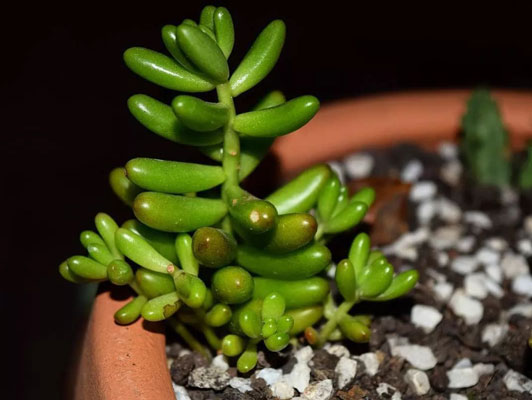
Sedum rubrotinctum ‘Aurora’, ‘Pink Jelly Beans’
The base version of this plant is red, but ‘Aurora’ has leaf tips in lovely shades of pink. This gives the plant a soft, intricate look.
Where to Grow Jelly Bean PlantHow to Propagate Jelly Bean Plant Jelly Bean Plant Propagation with Stem CuttingsJelly Bean Plant Propagation with Leaf CuttingsHow to Care for Jelly Bean Plant Jelly Bean Plant Light RequirementsJelly Bean Plant Soil CareJelly Bean Plant WateringJelly Bean Plant Temperature & Humidity CareJelly Bean Succulent Care - FertilizerJelly Bean Plant PruningJelly Bean Plant Pests & DiseasesVarieties of Jelly Bean PlantJelly Bean Plant Care FAQIs Jelly Bean Succulent Poisonous?Why are the Leaves Falling off My Jelly Bean Succulent?How do You Revive a Dying Succulent?
Where to Grow Jelly Bean Plant
Jelly bean plant needs a sunny spot to maintain colorful leaves. sedum succulent varieties often grow in areas of the landscape where nothing else survives because of hot, dry conditions. You can also grow the jelly bean plant in partially shaded areas for a pop of color, just plant someplace where a few hours of the sun can reach the plant. In the hottest climates, Jelly bean succulent needs some shade in summer.How to Propagate Jelly Bean Plant
Jelly Bean Plant Propagation with Stem Cuttings
Jelly Bean succulents are not only easy to care for but also one of the easiest succulents to propagate, and the fastest way is through cutting, as they root easily and often on their own without any help.To do this, simply follow the step-by-step guide below:
- Using a clean sharp scissor, snip a stem that has begun to trail or become long to cut. You can also choose one that already has roots growing on them.
- Since the stems of Jelly Beans are thin and dry faster compared to other succulents, you will only need to give it a day or 2 to callous over.
- Stick your stem cuttings in a well-draining potting mix and place it in a bright area but away from direct sunlight.
- Make sure to mist water your stem cuttings every few days, or when the soil feels dry to the touch.
- Cut back your watering to about once a week once the cuttings have established roots in a few weeks, and slowly increase sun exposure as the plant matures.

Jelly Bean Plant Propagation with Leaf Cuttings
Sedum jelly bean succulent can also be propagated through leaves. However, it would be slower but works just as well when propagating Jelly Bean succulent through cuttings.Here's a step-by-step guide on how to propagate your Jelly Bean plants from leaves.
- To start, you can either use a fallen leaf or break off your own from the stem. Keep in mind that the leaf needs to be whole from the tip to the end for propagation to work, and make sure to use a plump, healthy-looking one to get a higher chance of success. Dried up or shriveled leaves will most likely not make it.
- Set the leaves aside and allow them to dry out. The leaves can then be set on well-draining soil and place away from direct sunlight, as leaving it under the full sun will risk it to shrivel up and burn.
- In a span of a few weeks, your leaves should have started established. Once it does, mist the soil every few days or when the soil dries out.
- Continue misting every few days or when the soil felt dries out to the touch even after a new baby plant has emerged from the original leaf.
- Slowly increase sunlight exposure and decrease watering to once a week or when the soil feels dry as your new plant matures.

How to Care for Jelly Bean Plant
Jelly Bean Plant Light Requirements
Jelly Bean Plant (Sedum rubrotinctum) is an evergreen, low-growing perennial succulent that loves sunlight. When happily stressed, the leaves of these succulents turn to a brilliant shade of red but will turn green all over when not enough light reaches them. So if you want to maintain their colorful leaves, place this plant in a bright sunny location where it can get at least 6 hours of sunlight per day. You can also put your Sedum Jelly bean succulent in partially shaded areas where a few hours of the sun can reach the plant for a pop of color.During a heatwave, make sure to move your Jelly Bean succulent to a shadier spot to prevent the risk of sun damage. You can also give it some sun protection or shade, especially during the intense summer heat, where the sun can really scorch the plants if left unprotected.
When growing indoors, grow Jelly Bean succulent in a spot where it can get approximately 5 to 6 hours of light a day to thrive, like near east, south, or west-facing windows.
Jelly Bean Plant Soil Care
Jelly Bean Plant (Sedum rubrotinctum) tolerate a wide range of well-drained soils. These plants do not tolerate excess moisture well and are extremely susceptible to root rot. Succulent and cactus soils are ideal because they are typically high in inorganic matter (such as perlite and pumice) and low in organic matter (such as peat and coco coir).Jelly Bean Plant Watering
When it comes to watering Jelly Bean succulents, how and when actually depends on the climate you live in. For example, in the summer months, your jelly bean succulents should be watered deeply once every 7-10 days, sometimes more during a heatwave. In Spring and Fall, where the temperature cools down, your watering should be cut back to once every 10-14 days. In the winter months, on the other hand, watering it once a month or every 2 to 3 weeks (depending on how dry the soil gets) should be enough for them to survive.A good rule of thumb here to tell whether it’s time to water your Jelly Bean succulent is to check the moisture of the soil. You can either use a moisture meter or your finger to feel if the top inch needs are already dry before watering again. If you are unsure how much and how often to water, it’s always better to underwater and adjust your watering as needed.
- Also Read: How Big Do Succulents Grow
Jelly Bean Plant Temperature & Humidity Care
These desert-dwellers do best in hot, dry conditions and will struggle to survive in overly humid environments. Jelly Bean succulents are not frost-tolerant, although they can grow well outdoors if temperatures don’t drop below 20 degrees Fahrenheit (-6.7 degrees Celsius).Jelly Bean Succulent Care - Fertilizer
Jelly Bean Plant do not require regular fertilization and do well in nutrient-poor conditions. You can apply an all-purpose cactus and succulent fertilizer in the early to mid-spring to help support healthy growth throughout the growing season, it's not necessary. Over-fertilizing jelly bean succulents can result in root burn or discolored leaves, so apply sparingly.Jelly Bean Plant Pruning
If your belly Bean Plant is getting bigger than you want or has some unappealing stems, you can easily prune it. This is entirely cosmetic though.To prune Jelly Bean succulent, use sharp pruning shears that will make a clean cut without crushing the stem. Keep the cut area dry until it calluses over in a few days.
Jelly Bean Plant Pests & Diseases
Jelly Bean Plant (Sedum rubrotinctum) are susceptible to some common pests such as mealybugs and scale. If you notice an infestation, use a cotton swab and rubbing alcohol to remove any visible pests from the plant, and then use insecticidal soap to treat the plant. Continue this treatment until the infestation is resolved.Fungus gnats can also sometimes be a problem if the soil is too moist. For succulents, this can usually be resolved quickly by letting the soil dry out for extended periods of time to kill off any larvae that are thriving in the moist soil. When you resume watering Jelly Bean succulent, use a 10:1 mixture of water and hydrogen peroxide to kill off any remaining larvae.

Varieties of Jelly Bean Plant
Sedum rubrotinctum hasn't been heavily developed by growers for variations. The most common variety is referenced by its botanical name, and it has one named cultivar. There’s no difference in care between these two.Sedum rubrotinctum ‘Aurora’, ‘Pink Jelly Beans’
The base version of this plant is red, but ‘Aurora’ has leaf tips in lovely shades of pink. This gives the plant a soft, intricate look.
Jelly Bean Plant Care FAQ
Is Jelly Bean Succulent Poisonous?
Yes. Not only is Jelly Bean Plant toxic to humans and pets, it can irritate the skin. If you have pets or children, this may not be the plant for you.Why are the Leaves Falling off My Jelly Bean Succulent?
The Jelly Bean succulent leaves fall off easily when the plant is moved or brushed against. However, this is also a sign of overwatering. If the fallen leaves are discolored or mushy, you'll need to adjust your watering schedule.How do You Revive a Dying Succulent?
The most common cause of death in Jelly Bean succulents is overwatering. If your plant is mushy and discolored and the soil is retaining water, you need to lay off the watering can. Repot the succulent in dry soil and give it a couple of days before watering again. Other causes of succulent death are underwatering and rot. Underwatered plants need a more consistent watering schedule. Rotted sections need to be removed.Latest Updated
- Benefits of Bugleweed - 7 Science-backed Health Benefits
- Bugleweed Dangers & Side Effects - Is It Poisonous?
- How to Plant Evergreen Trees - What You Should Know
- When to Plant Evergreens - Grow Guide for Evergreen Trees
- 12 Wonderful Evergreen Shrubs for Your Garden
- 12 Popular Evergreen Plants with Pictures for Beginners
- When And How To Prune A Lilac Bush Like a Pro
- How to Grow & Care for Lilac Vine (Hardenbergia Violacea)
- Japanese Lilac Tree (Syringa Reticulata) Care & Propagation Guide
- Shumard Oak Pros and Cons - What to Know
Popular Articles
- Winter maintenance of Antirrhinum Majus
- How to Grow Terminalia Mantaly Tree
- How to Grow and Care for Crossostephium Chinense
- How to grow Antirrhinum Majus in spring
- Peristeria Elata (Dove Orchid) Profile: Info & Care Guide
- Underwatered Snake Plant (Sansevieria Trifasciata) - Signs And How To Fix
- How to Care for Brazilian Jasmine Plant (Mandevilla Sanderi)
- How to Grow & Care for Graptopetalum Purple Delight in Summer
- Rosa Chinensis (China Rose): Plant Growing & Care Tips
- How to Care for Baby Sun Rose (Aptenia Cordifolia)
